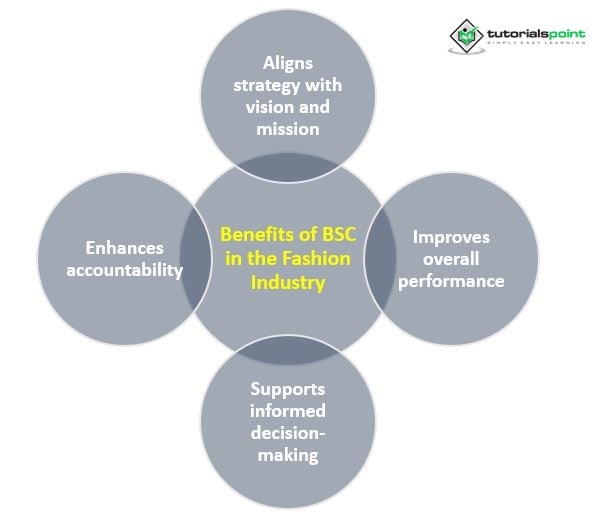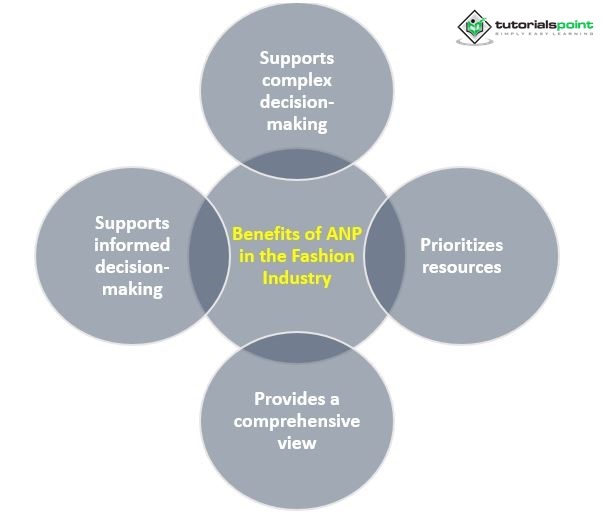

The BSC provides a comprehensive framework for measuring organizational performance by considering financial, customer, internal processes, and learning and growth perspectives. ANP, on the other hand, is a multi-criteria decision-making method that helps organizations prioritize objectives and make informed decisions by considering the interdependencies and trade-offs between different objectives. By using these tools, organizations in the fashion industry can gain a deeper understanding of their strengths and weaknesses and make data-driven decisions to drive innovation and achieve long-term success.

It can be understood under the following sub-headings
Uses − The BSC can be used to track and measure key performance indicators (KPIs) across four different perspectives: financial, customer, internal processes, and learning and growth.
Importance − By using the BSC, fashion companies can ensure that they are making progress towards their long-term goals and objectives while also improving their overall operations. The BSC provides a comprehensive view of the company's performance and helps identify areas where improvements can be made.
Implementation − To implement the BSC in the fashion industry, companies should first identify their goals and objectives. Next, they should select the KPIs that are most relevant to their business and track them regularly. Finally, they should use the information gathered from the KPIs to make informed decisions about their strategy, operations, and investments.
It can be understood under the following sub-headings
Uses − The ANP can be used to assess the importance of different factors in a particular decision, such as market trends, consumer preferences, production costs, and distribution channels.
Importance − By using ANP, fashion companies can priorities their resources and allocate them effectively to achieve their strategic goals. The ANP process provides a comprehensive view of the interdependencies between the different factors, helping organizations make informed decisions about their strategy.
Implementation − To implement the ANP in the fashion industry, companies should first identify the factors that are most relevant to their decision-making process. Next, they should create a network of relationships between the different factors and evaluate their relative importance. Finally, they should use the information gathered from the ANP process to make informed decisions about their strategy, investments, and operations.
The Balanced Scorecard (BSC) is a management tool that helps organizations align their strategy with their vision and mission. In the fashion industry, the BSC can be used to track and measure the performance of different aspects of the business, such as customer satisfaction, internal processes, financial results, and learning and growth. By using the BSC, fashion companies can ensure that they are making progress towards their long-term goals while also improving their overall operations. The BSC can also provide insights into areas where the company may need to focus their efforts in order to improve their performance and remain competitive in the fast-paced fashion industry.
The Analytic Network Process (ANP) is a decision-making tool that helps organizations consider multiple, complex, and interdependent factors when making strategic decisions. In the fashion industry, ANP can be used to assess the importance of different factors in a particular decision, such as market trends, consumer preferences, production costs, and distribution channels. ANP can also help fashion companies’ priorities their resources and allocate them effectively to achieve their strategic goals. The ANP process involves creating a network of relationships between the different factors and evaluating the relative importance of each factor in the overall decision. This information can then be used to make informed decisions about the company's strategy, investments, and operations.
Balanced Scorecard (BSC) applications in the Fashion Industry
A fashion retailer using the BSC to track customer satisfaction may track metrics such as the number of customer complaints, the average response time to customer inquiries, and customer loyalty.
A fashion company using the BSC to track internal processes may track metrics such as the efficiency of their supply chain, the number of on-time deliveries, and the number of production errors.
A fashion brand using the BSC to track financial results may track metrics such as revenue growth, profit margins, and return on investment.
These are
A fashion company considering a new product line may use ANP to assess the relative importance of different factors such as consumer demand, production costs, and distribution channels.
A fashion brand considering a new marketing campaign may use ANP to evaluate the impact of different marketing strategies on consumer preferences, brand recognition, and sales.
A fashion retailer considering expanding into a new market may use ANP to weigh the risks and benefits of different market opportunities, including factors such as consumer demand, competition, and the regulatory environment.
Benefits of the Balanced Scorecard (BSC) in the Fashion Industry
Aligns strategy with vision and mission − The BSC helps fashion companies align their strategy with their long-term goals and objectives, ensuring that they are making progress towards their vision and mission.
Improves overall performance − By tracking key performance indicators (KPIs) across different perspectives, the BSC provides a comprehensive view of the company's performance and helps identify areas where improvements can be made.
Supports informed decision-making − The information gathered from the BSC can be used to make informed decisions about the company's strategy, operations, and investments.

Enhances accountability − The BSC helps hold individuals and teams accountable for their performance by tracking KPIs and measuring progress towards goals.
These are
Supports complex decision-making − ANP helps fashion companies consider multiple, complex, and interdependent factors when making strategic decisions.
Prioritizes resources − By evaluating the relative importance of different factors, ANP helps fashion companies prioritize their resources and allocate them effectively to achieve their strategic goals.
Provides a comprehensive view − The ANP process provides a comprehensive view of the interdependencies between the different factors, helping organizations make informed decisions about their strategy.

Supports informed decision-making − The information gathered from the ANP process can be used to make informed decisions about the company's strategy, investments, and operations.
The Balanced Scorecard (BSC) and the Analytic Network Process (ANP) can be integrated in the fashion industry to provide a comprehensive and effective approach to strategy management.
Prioritizing KPIs − The ANP can be used to assess the importance of different factors that affect the fashion industry and then prioritize the KPIs that will be tracked using the BSC.
Improved decision-making − The ANP can help identify the factors that are most critical to the success of a particular decision, while the BSC can help track the impact of those decisions over time.
Aligned strategy − By integrating the ANP and the BSC, fashion companies can ensure that their strategy is aligned with their long-term goals and objectives and that their decisions are informed by both qualitative and quantitative data.
Comprehensive view − By using both the ANP and the BSC, fashion companies can gain a comprehensive view of their performance across multiple perspectives and make informed decisions about their strategy, operations, and investments.
The integration of these two approaches can provide a powerful tool for fashion companies to improve their overall performance and achieve their strategic goals.
In conclusion, the Balanced Scorecard (BSC) and the Analytic Network Process (ANP) are two powerful strategy management tools that can be effectively applied in the fashion industry. The BSC provides a comprehensive view of a company's performance across multiple perspectives, while the ANP helps companies make informed decisions by evaluating the relative importance of different factors. The integration of these two approaches can provide a powerful tool for fashion companies to align their strategy with their long-term goals, make informed decisions, and improve their overall performance. By using the BSC and ANP, fashion companies can better understand their strengths and weaknesses, identify areas for improvement, and make strategic investments to achieve their goals.